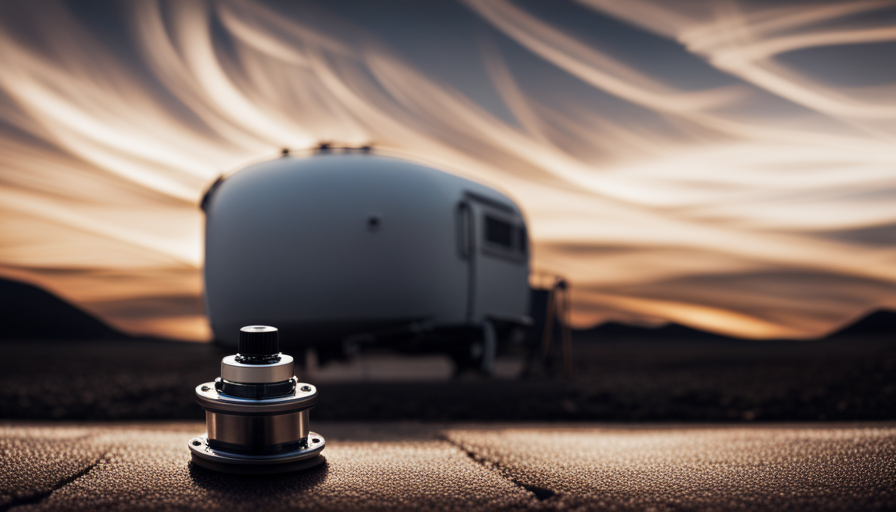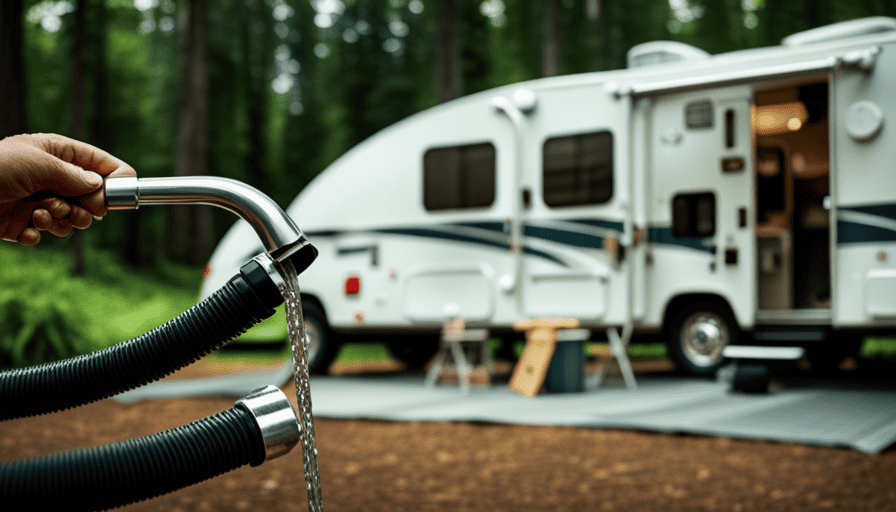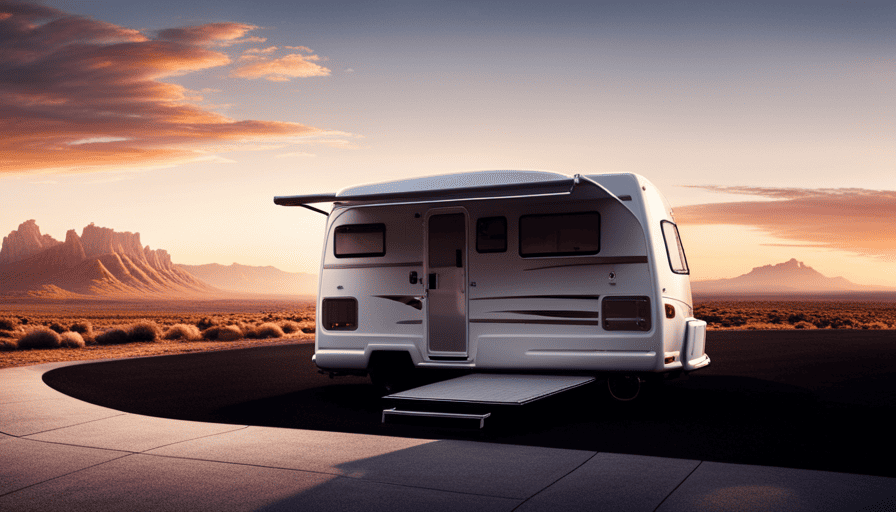When it comes to camping, there is no experience quite like traveling in a camper. The freedom, the adventure, the excitement of exploring new places – it’s all part of the journey.
But have you ever wondered about that mysterious black tank on a camper? Well, let me spill the beans for you.
The black tank, my friends, is the unsung hero of your camper’s waste management system. It’s like the calm before the storm, the quiet before the chaos. You see, when nature calls, the black tank answers. It’s where all the black water from your toilet goes, along with any other waste that finds its way down the drain.
Now, I know what you’re thinking – why on earth would I want to know about a tank full of waste? Well, my fellow campers, understanding the black tank is crucial for a smooth and enjoyable camping experience. From proper disposal to maintenance and troubleshooting, we’ve got you covered.
So buckle up and get ready to dive into the world of the black tank on a camper. It’s not as dirty as it sounds, I promise.
Key Takeaways
- The black tank on a camper is an essential part of the waste management system.
- Proper disposal and maintenance of the black tank are necessary to prevent odors and clogs.
- RV-friendly toilet paper and chemical treatments should be used for the black tank.
- Regular flushing and rinsing of the black tank help keep it clean and odor-free.
The Purpose of the Black Tank in a Camper
You might be wondering, "What’s that mysterious black tank in your camper?" Well, let me paint a picture for you: imagine a large, sturdy container nestled beneath your cozy home on wheels, dutifully collecting all the waste and sewage from your adventures on the road.
This black tank serves a crucial purpose in your camper – it ensures proper storage and disposal of the waste generated during your travels. Proper maintenance of the black tank is essential to keep your camper smelling fresh and functioning smoothly. Regularly emptying and cleaning the tank is necessary to prevent any unpleasant odors or clogs.
To maintain the black tank, it’s important to use RV-friendly toilet paper and chemical treatments designed specifically for waste management systems. Additionally, flushing the tank with plenty of water helps to break down the waste and keep everything flowing smoothly.
Now that you understand the purpose and importance of the black tank, let’s delve into how it works in the RV’s waste management system. It plays a crucial role in separating solid waste from liquid waste, allowing for easy disposal and treatment. So, let’s explore the inner workings of this vital component and discover how it keeps your camper’s waste management system running efficiently.
How the Black Tank Works in the RV’s Waste Management System
In the world of RV waste management, the mysterious ‘poop container’ plays a crucial role in keeping things clean and odor-free. The black tank, as it’s commonly known, is an essential component of an RV’s waste management system. Here’s how it works:
-
Understanding black water composition: The black tank is designed to hold the waste from the RV’s toilet. This waste, also known as black water, consists of human waste and toilet paper. It’s important to note that only biodegradable toilet paper should be used to prevent clogs and damage to the system.
-
Proper disposal methods for black water: When it comes time to empty the black tank, it’s important to follow the proper disposal methods. Most RV parks and campgrounds have designated dump stations where you can safely dispose of your black water. Always wear gloves and use a dedicated hose for this task. Additionally, it’s recommended to use RV-specific black tank treatment products to break down the waste and control odors.
Understanding black water and its proper disposal is essential for RV owners. By following these guidelines, you can ensure a clean and odor-free RV experience.
In the next section, we’ll delve deeper into the topic of black water and explore the best practices for its disposal.
Understanding Black Water and its Proper Disposal
When it comes to managing waste in an RV, understanding the proper disposal methods for black water is crucial. Proper disposal not only ensures a clean and functional black tank but also minimizes the environmental impact.
Black water, which consists of human waste and toilet paper, must be disposed of in designated dump stations or RV parks with sewer connections. Dumping black water in unauthorized areas or directly into the environment can contaminate water sources and harm ecosystems.
To properly dispose of black water, RV owners should locate dump stations along their travel routes and plan their trips accordingly. It’s important to follow all local regulations and guidelines when using dump stations to prevent any negative consequences. By doing so, we can contribute to the preservation of the environment and protect public health.
Moving on to tips for maintaining and cleaning the black tank, it’s essential to adopt regular maintenance practices that keep the tank odor-free and in good working condition.
Tips for Maintaining and Cleaning the Black Tank
To keep your RV’s black water system in good condition, it’s crucial to regularly maintain and clean the holding tank. Did you know that neglecting proper maintenance can lead to costly repairs and unpleasant odors, according to a study conducted by RV industry experts?
Maintaining the black tank involves a few essential steps that will ensure its longevity and functionality.
Firstly, it’s important to regularly flush out the tank with clean water. This helps remove any residual waste and prevents solids from building up. Additionally, using a tank cleaning wand or hose attachment can help reach those hard-to-reach areas and ensure a thorough cleaning.
Secondly, it’s recommended to use specialized RV toilet paper that is designed to break down quickly and easily in the black tank. This helps prevent clogs and allows for smoother waste flow.
Lastly, regularly using chemicals and additives can help control odors and break down waste inside the tank. These products contain enzymes and bacteria that naturally break down waste and reduce odors. Adding these chemicals after each dump and during each flush will help maintain a clean and odor-free black tank.
By following these tips for maintaining and cleaning the black tank, you can ensure a trouble-free camping experience. Now let’s explore how using chemicals and additives can further enhance your RV’s black water system.
Using Chemicals and Additives to Control Odors and Break Down Waste
Regularly using chemicals and additives is crucial for controlling odors and breaking down waste in your RV’s black water system. There are various options available, including chemical additives specifically designed for black tanks. These additives contain enzymes and bacteria that help break down solid waste, reducing the risk of clogs and ensuring a smoother flow.
However, it’s important to note that some chemical additives can be harmful to the environment. If you’re looking for eco-friendly alternatives, there are enzyme-based additives that are biodegradable and safe for the environment.
When it comes to using chemical additives, there are pros and cons to consider. On the positive side, they can effectively control odors and help break down waste, making the overall RV experience more pleasant. However, some additives may contain harsh chemicals that can damage the tank or toilet seals over time. Additionally, they can be expensive and may require frequent reapplication.
If you prefer alternative methods for odor control, there are a few options to consider. One popular method is using natural ingredients such as baking soda or vinegar to neutralize odors. These household items are readily available and can be effective in reducing unpleasant smells. Another option is regular tank flushing and rinsing, which helps keep the tank clean and odor-free.
Properly flushing and rinsing the black tank is essential for maintaining its functionality and preventing any potential issues.
Transitioning into the subsequent section about properly flushing and rinsing the black tank, it’s important to ensure that all waste and residue are thoroughly removed.
Properly Flushing and Rinsing the Black Tank
Flushing and rinsing the waste system ensures a clean and odor-free RV experience. Proper black tank maintenance is essential to keep your camper in good condition and prevent any unpleasant surprises during your trips.
Here are four key steps to properly flush and rinse the black tank:
-
Use a high-quality flushing system: Invest in a good flushing system that sprays water directly into the tank, ensuring a thorough cleaning. This will help remove any solid waste and prevent buildup.
-
Flush with plenty of water: After emptying the tank, add a sufficient amount of water and flush it again. This will help in breaking down waste and preventing odors.
-
Use a tank rinse wand: A tank rinse wand is a useful tool for reaching all corners of the black tank. Insert it through the toilet and move it around to ensure a thorough rinse.
-
Consider using tank cleaning products: There are special cleaning products available that can help break down waste and control odors. Follow the instructions on the product carefully to maintain the longevity of your tank.
Proper black tank maintenance can help avoid common black tank problems such as clogs and blockages. By following these steps, you can ensure a clean and odor-free black tank system, providing a more enjoyable camping experience.
Now let’s explore how to prevent clogs and blockages in the black tank.
Preventing Clogs and Blockages in the Black Tank
Avoiding clogs and blockages in the waste system ensures a worry-free and enjoyable RV experience. When it comes to the black tank on a camper, it’s essential to take preventive measures to keep it functioning properly.
One of the most important steps in preventing clogs is to use plenty of water when flushing the toilet. This helps to break down solid waste and prevent it from accumulating in the tank. Additionally, using RV-specific toilet paper that dissolves easily can also help prevent clogs.
Regularly flushing and rinsing the black tank is another crucial aspect of preventing clogs. After emptying the tank, it’s recommended to fill it with water and then flush it again to ensure all waste is thoroughly flushed out. This helps to prevent any residue from building up and causing blockages.
If you do encounter a clog in the black tank, there are several unclogging methods you can try. One popular method is using a specialized RV sewer hose attachment with a built-in jet spray. This attachment allows you to spray water directly into the tank, helping to break up any clogs. Another option is to use enzyme-based tank treatments that can help dissolve waste and keep the tank clean.
By following these preventive measures and knowing how to deal with clogs, you can ensure that your black tank remains free from blockages. This will help you avoid any unpleasant surprises and enjoy your RV adventures to the fullest.
Speaking of tank maintenance, let’s now discuss the signs of a full or malfunctioning black tank.
Signs of a Full or Malfunctioning Black Tank
As I mentioned earlier, preventing clogs and blockages in the black tank is crucial for maintaining your camper’s sanitation system. However, it’s equally important to be aware of the signs that indicate a full or malfunctioning black tank. Ignoring these signs can lead to unpleasant and costly problems down the road.
One common problem that campers encounter is a full black tank. If you notice that the toilet isn’t flushing properly or the waste isn’t draining as it should, it may be a sign that the black tank is nearing its capacity. Another indication of a full black tank is a foul odor coming from the toilet or RV.
On the other hand, a malfunctioning black tank can present itself with issues such as leaks, cracks, or even a faulty valve. These problems can lead to sewage leaks, which not only pose health risks but can also cause damage to your camper.
To avoid these common problems, regular maintenance is essential. Flushing the black tank regularly, using RV-friendly toilet paper, and adding bacteria-based treatments can help prevent clogs and keep the tank in good working condition.
In the next section, we’ll delve into troubleshooting common issues with the black tank, ensuring that you have the knowledge and tools to handle any problems that may arise.
Troubleshooting Common Issues with the Black Tank
If you’re experiencing leaks or foul odors, it’s time to roll up your sleeves and tackle the troubleshooting process for common issues with your black tank.
One of the most common problems is leaks, which can be caused by loose connections or damaged seals. To troubleshoot leaks, start by inspecting all the connections and tightening them if necessary. If the leaks persist, you may need to replace the seals or even the entire plumbing system.
Another issue that often arises with black tanks is dealing with odors. The key here is proper ventilation. Make sure that your vent pipe is clear and not obstructed by any debris. Additionally, using chemicals designed to neutralize odors can help keep things smelling fresh. Remember to follow the instructions on the chemicals and use them in the recommended amounts.
By troubleshooting leaks and dealing with odors, you can ensure that your black tank functions properly and efficiently.
Moving on to the next section on important safety precautions and best practices for handling the black tank, it’s essential to remember that proper maintenance and care are crucial for a trouble-free camping experience.
Important Safety Precautions and Best Practices for Handling the Black Tank
Ensuring a smooth and worry-free camping experience involves implementing essential safety precautions and following best practices when dealing with the maintenance of your waste disposal system. When it comes to handling the black tank on a camper, there are a few important safety precautions and best practices to keep in mind.
First and foremost, always wear gloves and protective eyewear when dealing with the black tank. This is crucial to protect yourself from any potential exposure to harmful bacteria or chemicals. Additionally, it’s important to handle chemicals used in the black tank with caution. Read and follow the instructions provided by the manufacturer when using any chemicals or additives.
When it comes time to empty the black tank, make sure to do so in a designated dump station or sanitary sewer connection. Avoid dumping the waste in unauthorized areas, as this can harm the environment and potentially violate local regulations.
Furthermore, it’s important to regularly clean and maintain the black tank to prevent any clogs or odors. Use a specialized RV black tank cleaner and follow the recommended cleaning schedule. This will help prolong the lifespan of the tank and ensure its efficient operation.
By following these safety precautions and best practices, you can ensure a safe and hassle-free experience when handling the black tank on your camper.
Frequently Asked Questions
Can the black tank be used for any other purpose besides waste disposal?
The black tank on a camper is primarily designed for waste disposal. However, there are some alternative uses for it, depending on the camper’s setup. Some campers use the black tank to store extra water for emergencies or for cleaning purposes.
It’s important to note that if you choose to repurpose the black tank, proper maintenance is crucial. Regularly cleaning and sanitizing the tank is essential to prevent any odors or contamination.
How often should the black tank be emptied?
To properly clean the black tank and prevent odors, it’s important to empty it regularly. We recommend emptying the black tank every 3-5 days or when it’s about 2/3 full. This ensures that waste doesn’t accumulate and cause unpleasant odors.
Additionally, using RV-specific toilet paper and adding specialized tank treatments can help break down waste and control odors. Regular maintenance and following these tips will keep your black tank clean and odor-free.
What are the signs of a malfunctioning black tank?
When it comes to signs of a malfunctioning black tank, there are a few key indicators to keep an eye out for. Firstly, if you notice any leaks or odors coming from the tank, it could be a sign of a problem.
Additionally, if the tank is not draining properly or if you experience frequent clogs, there may be an issue. To troubleshoot these problems, check for any blockages, ensure the tank is properly sealed, and consider using tank treatments to maintain its functionality.
Is it necessary to use chemicals or additives in the black tank?
Using chemicals or additives in the black tank is not necessary for proper maintenance, but it can be beneficial. Think of it as giving your tank a spa treatment. These products help break down waste and control odors, making your camping experience more pleasant.
However, it’s important to choose environmentally friendly options to minimize the impact on nature. So, while not essential, using the right chemicals or additives can enhance your black tank’s performance and keep the environment happy.
Are there any special safety precautions to take when handling the black tank?
When it comes to handling the black tank on a camper, there are indeed some important safety precautions to keep in mind. Firstly, it’s crucial to wear protective gloves and eye goggles to avoid any contact with harmful waste.
Additionally, having a designated hose for rinsing the tank is essential for maintaining cleanliness. Lastly, investing in special tools such as a tank wand or flush system can greatly assist in the maintenance of the black tank.
Remember these tips to ensure a safe and hygienic experience.
Is the Size of the Electric Jack Dependent on the Black Tank on a Camper?
The electric jack size for camper is not dependent on the size of the black tank. The electric jack is responsible for lifting and stabilizing the camper, while the black tank is for storing waste. These components serve different purposes and have no direct correlation in terms of their respective sizes.
Conclusion
In conclusion, the black tank is an essential component of a camper’s waste management system. It is responsible for holding and storing human waste, also known as black water, until it can be properly disposed of.
Maintaining and cleaning the black tank is crucial to prevent odors and clogs. By using chemicals and additives, you can effectively control odors and break down waste.
Regularly monitoring the tank’s levels and addressing any malfunctions promptly is important for a smooth camping experience. Remember, safety should always be a priority when handling the black tank.











